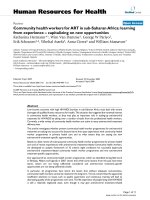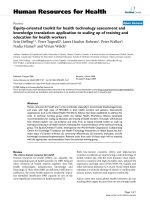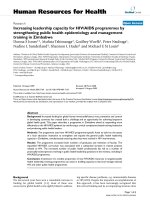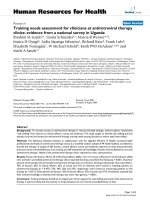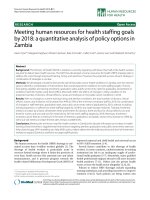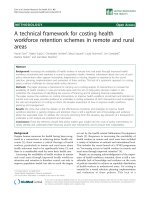Báo cáo sinh học: " Editorial Filter Banks for Next Generation Multicarrier Wireless Communications" potx
Bạn đang xem bản rút gọn của tài liệu. Xem và tải ngay bản đầy đủ của tài liệu tại đây (425.81 KB, 2 trang )
Hindawi Publishing Corporation
EURASIP Journal on Advances in Signal Processing
Volume 2010, Article ID 314193, 2 pages
doi:10.1155/2010/314193
Editorial
Filter Banks for Next Generation Multicarrier
Wireless Communications
Markku Renfors (EURASIP Member),
1
Pierre Siohan,
2
Behrouz Farhang-Boroujeny,
3
and Faouzi Bader
4
1
Department of Communications Engineering, Tampere University of Technology, P.O. Box 553, 33101 Tampere, Finland
2
Orange Labs, France Tel
´
ecom, 4 Rue du Clos Courtel, B.P. 91226, 35512 Cesson S
´
evign
´
eCedex,France
3
Department of Electrical and Computer Engineering, University of Utah, Salt Lake City, UT 84112-9206, USA
4
Centre Tecnologic de Telecommunication de Catalunya (CTTC), Parc Mediterrani de la Tecnologia,
Avinguda del Canal Olimpic, Casstelldefels, 08860 Barcelona, Spain
Correspondence should be addressed to Markku Renfors, markku.renfors@tut.fi
Received 3 May 2010; Accepted 3 May 2010
Copyright © 2010 Markku Renfors et al. This is an open access article distributed under the Creative Commons Attribution
License, which permits unrestricted use, distribution, and reproduction in any medium, provided the original work is properly
cited.
The theoretical capacity limits in communications can be
approached by multicarrier techniques. With radio channels,
multicarrier techniques can be combined with multiantenna
transmitters and receivers to provide efficiency. Existing or
planned transmission systems rely on the OFDM technique
to reach these goals and a considerable amount of research
has been devoted to these techniques during the last 20
years. However OFDM has a number of drawbacks, such
as the use of the cyclic prefix to cope with the channel
impulse response which results in a loss of capacity and the
requirement of block processing to maintain orthogonality
among all the subcarriers. Furthermore, the leakage among
frequency subbands has a serious impact on the performance
of FFT-based spectr um sensing and OFDM-based cognitive
radio in general.
On the other hand, digital filter banks find various
good applications in communications signal processing. In
general, they can be used to obtain very sharp frequency
selectivit y to isolate different communications frequency
channels from each other and from interfering spectral
components. This can be done in a very flexible and
dynamic manner. Thus filter banks constitute a very powerful
generic tool for software-defined radios and spec trally agile
communication systems.
So far, some attempts have been made to introduce filter
bank multicarrier (FBMC) in the radio communications
arena, through proprietary schemes, in particular the IOTA
(Isotropic Orthogonal Transform Algorithm). However, the
full exploitation and optimization of FBMC techniques in the
context of radio evolution, such as dynamic access, as well
as their combination with MIMO techniques, have not been
considered sufficiently.
This special issue aims to report advances in these
communication aspects of FBMC, helping to make full use
of FBMC as a new physical layer for future radio communi-
cation systems. We received 18 submission altogether, out of
which ten were accepted through a peer review process.
The first paper, “Cosine modulated and offset QAM filter
bank multicarrier techniques: a continuous-time prospect”
authored by B. Farhang-Boroujeny and C. H. ( George)
Yuen, presents a tutorial review relating the classical works
on FBMC systems, developed prior of the era of OFDM,
to the main filter bank design approaches used today for
FBMC systems. The paper also reviews the recent novel
developments in the design of FBMC systems that are tuned
to cope with fast fading wireless channels.
N. Moret and A. M. Tonello address the efficient
realization of a filtered multitone (FMT) modulation system
in the second paper entitled “Design of orthogonal filtered
multitone modulation systems and comparison among efficient
realizations”. The paper analyzes three different realization
structures, presenting also numerical comparisons, and
compares the best FMT approach with a cyclically prefixed
OFDM system in the IEEE 802.11 wireless LAN channel.
2 EURASIP Journal on Advances in Signal Processing
The third paper, “Optimized paraunitary filter banks for
time-frequency channel diagonalization” by Z. Ju et al. devel-
ops a method to diagonalize a doubly dispersive channel in
the time-frequency domain using a filter bank approach. The
related paraunitary filter bank design problem is formulated
as a convex optimization problem, and the performance of
the resulting window is investigated under different channel
conditions.
The fourth paper, “Spectral efficiency comparison of
OFDM/FBMC for uplink cognitive radio networks” by H.
Zhang et al. studies channel capacity of cognitive radio
(CR) networks using CP-OFDM and FBMC waveforms,
taking into consideration the effects of resource allocation
algorithms, intercell interference due to timing offsets, and
Rayleigh fading. Final results show that FBMC can achieve
higher channel capacity than OFDM because of the low
spectral leakage of its prototyp e filter.
M. Shaat and F. Bader address the problem of resource
allocation in multicarrier-based CR networks in the fifth
paper entitled “Computationally efficient power allocation
algorithm in multicarrier-based cognitive radio networks:
OFDM and FBMC systems”. The objective is to maximize the
downlink capacity of the network under constraints on both
total power and interference introduced to the primary users.
The performance of the proposed low-complexity algorithm
is investigated for OFDM- and FBMC-based CR systems.
In the sixth paper, “Packet format design and decision
directed tracking methods for filter bank multicarrier systems”,
P. Amini and B. Farhang-Boroujeny develop a packet format
for FBMC systems together with algorithms for carrier
frequency and timing recovery. Also methods for channel
estimation as well as carrier and timing tracking loops are
proposed.
In the se venth paper, entitled “Joint symbol timing and
CFO estimation for OFDM/OQAM systems in multipath
channels”, T. Fusco et al. develop different maximum-
likelihood based approaches for estimating carrier-frequency
offsets and symbol timing offsets using short preambles in
the FBMC transmission bursts. Good performance for a low-
complexity approximate ML estimator is demonstrated.
The eighth paper, “Pilot-based synchronization and equal-
ization in filter bank multicarrier communications” authored
by T. H. Stitz et al., presents a detailed analysis of synchro-
nization and channel estimation methods for FBMC based
on scattered pilots. The special problems related to using
scattered pilot-based schemes in FBMC are highlighted.
The channel parameter estimation and compensation are
successfully performed totally in the frequency domain, in
a subchannel-wise fashion, which is appealing in spectrally
agile and cognitive radio scenarios.
The ninth paper is entitled “Decoding schemes for FBMC
w ith single-delay STTC” and authored by C. L
´
el
´
eandD.
Le Ruyet. The paper develops space-time trellis coding
schemes for FBMC, addressing the challenge that the OQAM
signal model of FBMC makes the decoding process more
challenging compared to the CP-OFDM case. The developed
iterative decoding scheme for FBMC is shown to slightly
outperform CP-OFDM.
The tenth paper, “The Alamouti scheme with CDMA-
OFDM/OQAM” by C. L
´
el
´
e et al. introduces first the fact that
the well-known Alamouti decoding scheme cannot be simply
combined with the OQAM subcarrier modulation scheme of
FBMC. The paper then develops Alamouti coding schemes
by combining CDMA component with OFDM/OQAM.
We would like to thank all authors for their contributions
to our special issue, the reviewers for their help in selecting
papers, and the Editor-in-Chief Phillip Regalia and the
Editorial Office of the Journal for their support.
Markku Renfors
Pierre Siohan
Behrouz Farhang-Boroujeny
Faouzi Bader

